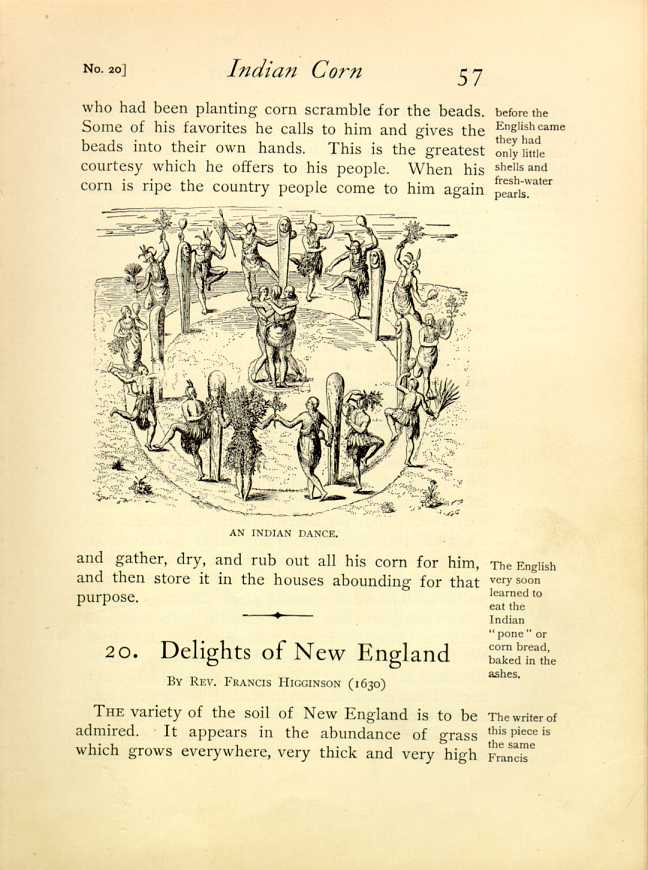19. How to grow Indian Corn
BY HENRY SPELMAN (1689)
THE Indians have houses, but few of the greatest
towns have more than twenty or thirty of them. Their
buildings are made like an oven, with a little hole through
which they go out and in. In the midst of the house there is
a hole through which the smoke goes out. The king's houses
are broader and longer than those of the other people, having
many dark windings and turnings.[84]
When the Indians go hunting, the women go to a place
assigned beforehand to build wigwams for their husbands to
sleep in at night. They carry mats to cover these huts, and as
the men go further in their hunting, the women go on ahead,
carrying the mats.
By the side of their dwelling-houses the Indians commonly
make a place to plant their corn. If there be much wood in
that place, they cut down the larger trees, and the smaller
trees they burn to the root, pulling most of the bark from
them so as to make them die. In these cornfields they used to
dig holes with a crooked piece of wood. Since then the English
have brought them shovels and spades. They put into these holes
ordinarily four or five kernels of their wheat, and two
beans.
[85] When the wheat has grown up, having a stalk as
big as a cane reed, the beans run up on them, like our hops on poles.
The ear of the wheat is long alla thick, and yet for all
its coarseness, the stalk has commonly four or five ears. Their
corn is planted and gathered at about the same time as ours, but
their manner of harvesting is like our way of gathering apples.
First they put the ears in hand baskets, then empty them into
larger baskets, made of the bark of trees or of hemp. Then
they lay the corn upon thick mats in the sun to dry, and every
night they make a great pile of it, covering it with mats to
protect it from the dew. When it is safely weathered, they pile
it up in their houses, and daily as they want to use some of the
corn they rub the kernels off into a great basket, wringing the
ears between their hands. A great basket of this takes up the
best part of some of their houses. Shelling corn is chiefly
women's work, for the men only hunt to get skins in winter and
dress them in summer.
But though now it is out of our purpose, we may not forget
altogether the planting of the King's corn, for which a day is
appointed.[86] On that day a great party of
the country people meet and work so hard that the greater part of the
King's corn is planted in one day. After the planting is over the King
takes the crown which the King of England sent him, and puts it upon his
head. This done, the people go backwards and forwards among the corn
hills he King following. Their faces are always towards the King,
expecting that he will throw some beads among
them.[87] It is his custom at such a time to make those
who had been planting corn scramble for the beads. Some of his
favorites he calls to him and gives the beads into their own
hands. This is the greatest courtesy which he offers to his
people. When his corn is ripe the country people come to him
again
and gather, dry, and rub out all his corn for him and then
store it in the houses abounding for that
purpose.
[88]
[[84]]
The early settlers called the Indian chiefs
"kings."
[[85]]
"Their wheat" means Indian corn; the Indians did not
have real wheat.
[[86]]
The Indian King, that is, the chief.
[[87]]
The beads were brought from Europe and the Indians
greatly valued them; before the English came the had only little shells
and fresh-water pearls.
[[88]]
The English very soon learned to eat the Indian pone
or corn bread, baked in the ashes.
